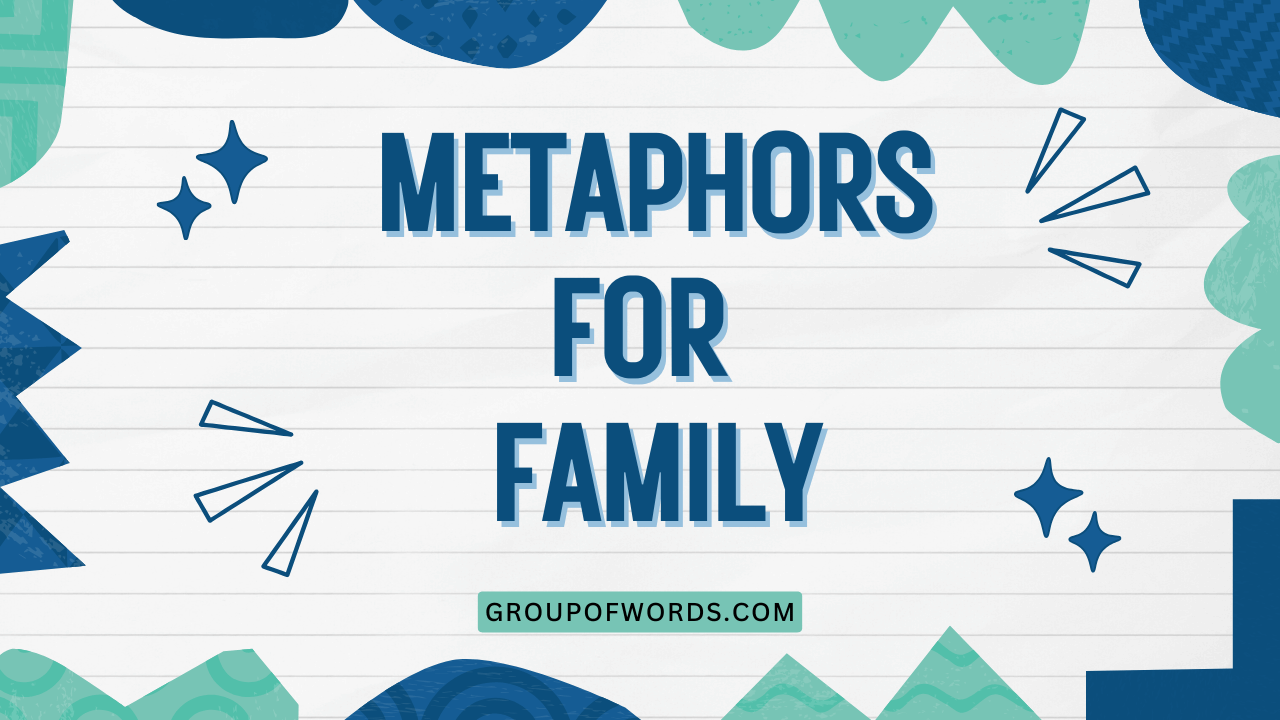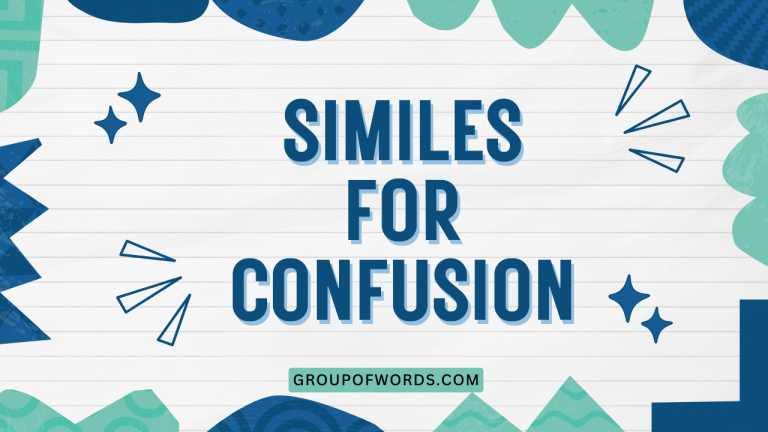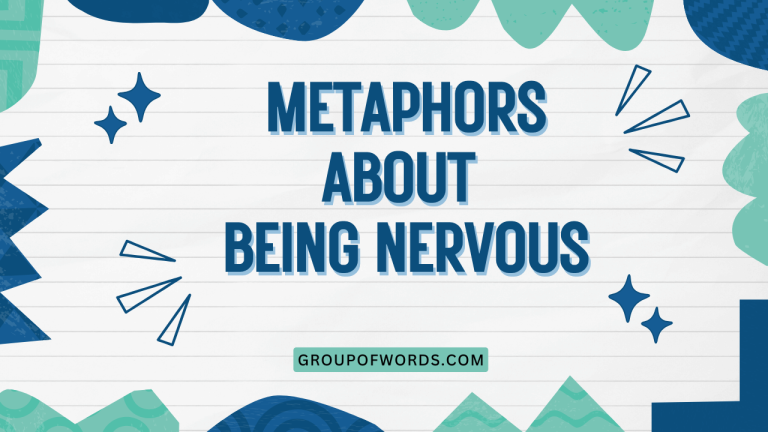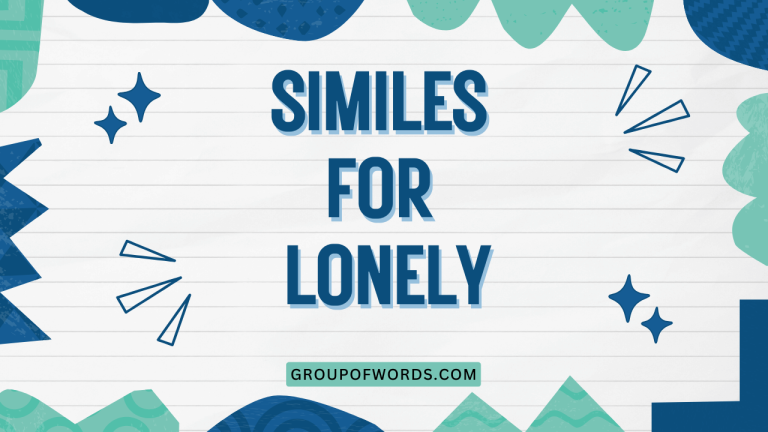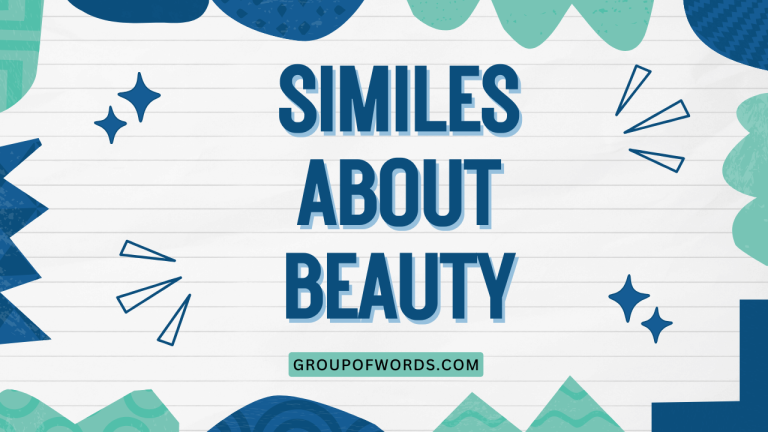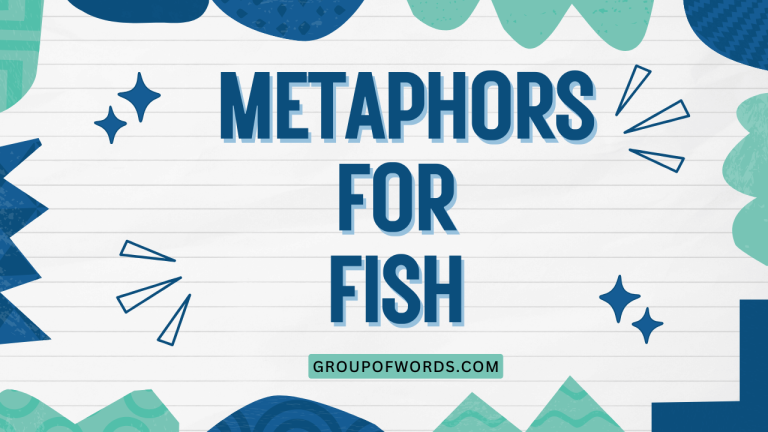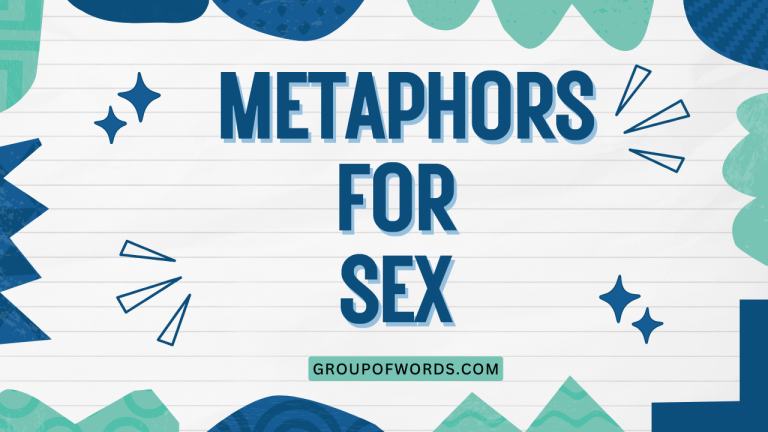Family as a Metaphor: Understanding Figurative Language
Metaphors are powerful tools in the English language, allowing us to understand complex concepts by relating them to something familiar. When we use metaphors to describe family, we tap into deeply ingrained emotions and experiences, creating vivid and relatable imagery.
Understanding these metaphors not only enriches our comprehension of literature and everyday conversations but also provides insight into how we perceive and value family relationships. This article will explore the various ways family is used metaphorically, providing examples, usage rules, and practice exercises to enhance your understanding of this fascinating aspect of language.
This guide is perfect for English language learners, students of literature, and anyone interested in exploring the nuances of figurative language.
This article will comprehensively cover the use of metaphors for family, providing a detailed exploration of their meanings, applications, and significance in both literature and daily conversation. By understanding these metaphors, readers can gain a deeper appreciation for the complexities of family dynamics and the power of language to convey profound emotions and relationships.
This guide aims to equip readers with the knowledge and skills to identify, interpret, and utilize family metaphors effectively, enhancing their linguistic abilities and cultural understanding.
Table of Contents
- Introduction
- Definition of Family Metaphors
- Structural Breakdown of Family Metaphors
- Types and Categories of Family Metaphors
- Examples of Family Metaphors
- Usage Rules for Family Metaphors
- Common Mistakes with Family Metaphors
- Practice Exercises
- Advanced Topics in Family Metaphors
- Frequently Asked Questions (FAQ)
- Conclusion
Definition of Family Metaphors
A metaphor is a figure of speech that directly compares two unlike things without using “like” or “as.” It asserts that one thing is another, creating a vivid and often insightful connection. When applied to family, metaphors allow us to understand the complex dynamics, roles, and emotions associated with familial relationships by comparing them to other concepts or objects. These comparisons can highlight the strengths, challenges, and unique characteristics of a family unit.
Family metaphors function to provide deeper meaning and emotional resonance when describing familial relationships. They go beyond literal descriptions, offering a more nuanced and evocative portrayal of the bonds, responsibilities, and experiences shared within a family.
By tapping into universally understood concepts, these metaphors can make abstract ideas about family more tangible and relatable.
Family metaphors can be found in various contexts, including literature, poetry, everyday conversations, and even legal and political discourse. In literature, they add depth and symbolism to characters and themes.
In everyday conversations, they provide a shorthand way to express complex feelings about family. In legal and political contexts, they can be used to argue for certain policies or perspectives on family matters.
The usage of family metaphors is widespread and versatile, reflecting the central role of family in human experience.
Structural Breakdown of Family Metaphors
The basic structure of a family metaphor involves two key elements: the tenor and the vehicle. The tenor is the subject being described (in this case, the family or a specific aspect of family), and the vehicle is the object or concept to which the family is being compared. The effectiveness of a metaphor lies in the connection between the tenor and the vehicle, which should highlight shared characteristics or qualities.
For example, in the metaphor “Family is the root of society,” the tenor is “family,” and the vehicle is “root.” The shared characteristic is the idea of foundation and support. Roots provide stability and nourishment to a plant, just as families provide stability and support to individuals and society as a whole.
Understanding this basic structure allows us to analyze and interpret family metaphors more effectively. By identifying the tenor and the vehicle, we can uncover the underlying meaning and appreciate the nuances of the comparison.
This analytical approach enhances our understanding of how language shapes our perceptions of family.
Let’s break down another example: “Our family is a well-oiled machine.” Here, the tenor is ‘our family,’ and the vehicle is ‘a well-oiled machine.’ The shared characteristic is efficiency and smooth operation. This metaphor suggests that the family members work together harmoniously and effectively to achieve their goals.
The success of a metaphor often depends on the context and the audience’s understanding of the vehicle. If the audience is unfamiliar with the concept of a ‘well-oiled machine,’ the metaphor may not be as effective.
Types and Categories of Family Metaphors
Family metaphors can be categorized based on the specific concepts or objects to which the family is being compared. Here are some common categories:
Family as a Tree
This metaphor emphasizes the ideas of roots, growth, and interconnectedness. The family tree is a common visual representation of this metaphor, showing the lineage and branches of a family.
The roots symbolize the ancestors and the foundation of the family, while the branches represent the descendants and the various directions the family has grown. The trunk represents the core values and traditions that hold the family together.
The leaves represent the individual members of the family, each unique but connected to the whole.
Examples: “Our family has deep roots in this community.” “She is a chip off the old block.” “The family tree is strong and resilient.”
Family as a Team
This metaphor highlights the importance of cooperation, support, and shared goals. Family members work together to overcome challenges and achieve success.
Each member has a specific role to play, and their contributions are essential to the overall functioning of the team. Communication, trust, and mutual respect are key elements of a successful family team.
Examples: “We’re a team, and we support each other.” “He’s a valuable player on our family team.” “Together, we can achieve anything.”
Family as a Foundation
This metaphor emphasizes the idea of stability, security, and support. The family provides a solid base upon which individuals can build their lives.
It offers a sense of belonging and a safe haven from the outside world. A strong family foundation is essential for the well-being and success of its members.
Examples: “Family is the foundation of a strong society.” “She is the rock of our family.” “We built our lives on a foundation of love and trust.”
Family as a Garden
This metaphor emphasizes the need for care, nurturing, and growth. Family members are like plants that need to be tended and cultivated in order to thrive.
The gardener (often the parents) provides the necessary resources and guidance to help each plant reach its full potential. Weeds (conflicts or challenges) need to be removed in order for the garden to flourish.
Examples: “Our family is a garden that needs constant care.” “She nurtured her children like delicate flowers.” “Weeding out negativity is essential for a healthy family.”
Family as a Patchwork Quilt
This metaphor emphasizes the idea of diversity, uniqueness, and interconnectedness. Each family member is like a different patch of fabric, with their own unique colors, patterns, and textures.
When sewn together, these patches create a beautiful and cohesive whole. The quilt represents the family’s history, experiences, and memories.
Examples: “Our family is a patchwork quilt of different personalities.” “Each member brings their own unique thread to the family tapestry.” “We’re all stitched together by love and loyalty.”
Examples of Family Metaphors
Here are some tables containing extended examples of family metaphors, categorized by the types discussed above. Each example is designed to illustrate the specific nuances of the metaphor and how it can be used in different contexts.
The following table provides examples of the “Family as a Tree” metaphor. Note how each example draws on aspects of a tree to describe family relationships and characteristics.
| Metaphor | Explanation |
|---|---|
| “Our family has deep roots in this community.” | This highlights the family’s long history and strong connection to the community. |
| “She is a chip off the old block.” | This means she resembles her parents, especially in character or behavior. |
| “The family tree is strong and resilient.” | This suggests the family has overcome many challenges and continues to thrive. |
| “He’s the black sheep of the family.” | He is different from the rest of the family and doesn’t fit in. |
| “They are the roots that ground us.” | They provide stability and support to the family. |
| “She’s the fruit of our labor.” | She is the successful result of our hard work and dedication. |
| “The branches of our family extend far and wide.” | The family has many members spread across different locations. |
| “He’s the trunk that holds us all together.” | He provides strength and stability to the family. |
| “Our family is a growing tree, always reaching for the sky.” | The family is constantly evolving and striving for improvement. |
| “Like a tree, our family has weathered many storms.” | The family has faced and overcome many difficulties. |
| “The family is like a deeply rooted oak, unyielding to the winds of change.” | This emphasizes the family’s strength and resistance to external pressures. |
| “He’s climbing the family tree to uncover our history.” | He’s researching the family’s genealogy and ancestry. |
| “She’s the sapling, full of potential and promise.” | She’s young and has a bright future ahead of her. |
| “The family is a forest where each member is a unique tree contributing to the ecosystem.” | This highlights the diversity and interdependence of family members. |
| “His rebellious nature was like a broken branch, causing pain but eventually healing.” | This describes a period of conflict and eventual reconciliation within the family. |
| “The family legacy is like the rings of a tree, each year adding to its story.” | This emphasizes the accumulation of history and experiences over time. |
| “She is the sturdy trunk, providing unwavering support to her children.” | This highlights her role as a strong and reliable caregiver. |
| “The family is a sprawling orchard, bearing fruit for generations to come.” | This emphasizes the family’s productivity and long-term impact. |
| “They pruned away the toxic influences to help their family thrive.” | This refers to actively removing negative elements to foster a healthier environment. |
| “Like a tree that bends but doesn’t break, our family has shown incredible resilience.” | This emphasizes the family’s ability to adapt and persevere through challenges. |
| “The family gathered under the shade of their matriarch, finding comfort and wisdom.” | This depicts the matriarch as a source of guidance and support. |
| “He’s the seed of a new generation, carrying the family’s hopes and dreams.” | This emphasizes his role as a future bearer of the family legacy. |
| “Their love is the water that nourishes the roots of our family.” | This highlights the importance of love in sustaining the family bond. |
The following table provides examples of the “Family as a Team” metaphor. Notice how they emphasize cooperation, support, and shared goals.
| Metaphor | Explanation |
|---|---|
| “We’re a team, and we support each other.” | This emphasizes mutual support and collaboration within the family. |
| “He’s a valuable player on our family team.” | This recognizes his important contribution to the family’s success. |
| “Together, we can achieve anything.” | This highlights the power of teamwork and unity within the family. |
| “We’re all pulling in the same direction.” | This means everyone is working towards the same goals. |
| “She’s the coach of our family, guiding us through challenges.” | She provides leadership and direction to the family. |
| “We’re a well-oiled machine, working together seamlessly.” | This suggests the family functions efficiently and harmoniously. |
| “He’s the anchor of our team, providing stability and security.” | He offers a sense of groundedness and reliability to the family. |
| “We’re a team of problem-solvers, always finding creative solutions.” | This highlights the family’s ability to overcome obstacles. |
| “Each member plays a crucial role in our family’s success.” | This emphasizes the importance of everyone’s contributions. |
| “We’re a team of cheerleaders, always encouraging each other.” | This highlights the family’s supportive and uplifting nature. |
| “Our family operates like a pit crew, each member knowing their role to ensure success.” | This emphasizes coordinated effort and specialized roles within the family. |
| “They pass the baton of responsibility with grace and efficiency.” | This highlights the smooth transfer of duties and shared accountability. |
| “The family is a relay race, each generation carrying the torch forward.” | This emphasizes the continuation of traditions and values over time. |
| “They strategize like a winning team, planning their moves carefully.” | This highlights the family’s proactive and strategic approach to challenges. |
| “Their synergy is like a perfectly synchronized dance, each step complementing the other.” | This emphasizes the harmonious and coordinated interactions within the family. |
| “The family is a symphony orchestra, each instrument contributing to a beautiful melody.” | This highlights the unique talents and contributions of each member. |
| “They huddle together like a football team, strategizing their next move.” | This emphasizes the family’s collaborative problem-solving approach. |
| “Their bond is the glue that holds this team together, making them unstoppable.” | This highlights the importance of strong relationships in achieving success. |
| “Like a well-coordinated sports team, they anticipate each other’s needs and movements.” | This emphasizes the family’s deep understanding and responsiveness to one another. |
| “The family’s unity is their secret weapon, enabling them to conquer any obstacle.” | This highlights the power of solidarity and mutual support in overcoming challenges. |
| “They work together like a finely tuned clock, each component essential for smooth operation.” | This emphasizes the precision and efficiency of their teamwork. |
| “Their collaborative spirit is like a rising tide, lifting all boats in the family.” | This highlights the positive impact of mutual support and encouragement. |
| “The family is a puzzle, each member a unique piece that fits perfectly to complete the picture.” | This emphasizes the importance of each individual in creating a cohesive whole. |
The following table provides examples of “Family as a Foundation” metaphor. These examples emphasize stability, security, and support.
| Metaphor | Explanation |
|---|---|
| “Family is the foundation of a strong society.” | This emphasizes the fundamental role of family in societal stability. |
| “She is the rock of our family.” | This highlights her role as a source of strength and stability. |
| “We built our lives on a foundation of love and trust.” | This emphasizes the importance of these values in creating a secure family environment. |
| “He’s the backbone of our family.” | He provides essential support and strength. |
| “Our family is a safe haven from the outside world.” | This highlights the protective and comforting nature of the family. |
| “They are the pillars of our family, providing unwavering support.” | They offer essential strength and stability. |
| “Family is the bedrock upon which we build our lives.” | This emphasizes the fundamental importance of family. |
| “She’s the cornerstone of our family, holding everything together.” | She plays a vital role in maintaining family unity. |
| “Our family is a fortress, protecting us from harm.” | This highlights the family’s role as a source of safety and security. |
| “They are the foundation stones of our family history.” | They represent the origins and enduring legacy of the family. |
| “The family is an anchor in the turbulent sea of life, providing stability and direction.” | This emphasizes the family’s role in providing guidance and security amidst life’s challenges. |
| “Their love is the mortar that binds the bricks of the family together.” | This highlights the importance of love in maintaining family unity and strength. |
| “The family is a lighthouse, guiding its members through the storms of life.” | This emphasizes the family’s role in providing direction and support during difficult times. |
| “They are the solid ground on which we can always rely, no matter what.” | This highlights the family’s unwavering support and reliability. |
| “The family is a shield, protecting its members from the harsh realities of the world.” | This emphasizes the family’s role in providing safety and security. |
| “Their traditions are the blueprints that guide the construction of our family identity.” | This highlights the importance of traditions in shaping the family’s values and culture. |
| “The family is a compass, guiding its members towards their true north.” | This emphasizes the family’s role in helping individuals find their purpose and direction in life. |
| “They are the bedrock of our values, shaping our moral compass.” | This highlights the family’s influence in instilling ethical principles and values. |
| “Like a sturdy fortress, their family stood strong against adversity.” | This emphasizes the family’s resilience and ability to withstand challenges. |
| “The family’s bond is the cement that holds everything together, even in the face of cracks and fissures.” | This highlights the importance of strong relationships in maintaining family unity. |
| “They built their family on a solid foundation of mutual respect and understanding.” | This emphasizes the importance of these values in creating a harmonious family environment. |
| “Their love is the cornerstone of our family, providing unwavering support and guidance.” | This highlights the central role of love in sustaining the family bond. |
| “The family is a sturdy bridge, connecting generations and cultures.” | This emphasizes the family’s role in preserving and passing on traditions and values. |
Usage Rules for Family Metaphors
When using family metaphors, it’s important to consider the context and audience. The metaphor should be appropriate for the situation and easily understood by those who are listening or reading.
Avoid using clichés or overused metaphors, as they can lose their impact. Instead, strive to create fresh and original comparisons that resonate with your audience.
Ensure that the metaphor is consistent and logical. Avoid mixing metaphors or creating comparisons that don’t make sense.
The connection between the tenor and the vehicle should be clear and meaningful. If the metaphor is confusing or contradictory, it will detract from your message.
Be mindful of the emotional impact of the metaphor. Family metaphors can evoke strong feelings, so it’s important to use them sensitively and appropriately.
Avoid using metaphors that could be offensive or hurtful to others. Consider the cultural background of your audience and choose metaphors that are relevant and respectful.
Common Mistakes with Family Metaphors
One common mistake is using clichés or overused metaphors. For example, saying “Family is everything” is a cliché that lacks originality and impact.
Instead, try to create a more specific and evocative comparison.
Another mistake is mixing metaphors. For example, saying “Our family is a tree that’s also a well-oiled machine” is confusing and illogical.
Choose one metaphor and stick with it.
Misunderstanding the connotations of the vehicle is another frequent error. If you say, “My family is a circus,” intending to convey excitement and fun, but the audience associates circuses with chaos and disorganization, the metaphor will backfire.
Ensure your audience shares a similar understanding of the vehicle.
Here are some examples of common mistakes and their corrections:
| Incorrect | Correct | Explanation |
|---|---|---|
| “Family is everything.” | “Family is the compass that guides my life.” | The corrected version is more specific and evocative. |
| “Our family is a tree that’s also a well-oiled machine.” | “Our family is a well-oiled machine, working together seamlessly.” | The corrected version uses a single, consistent metaphor. |
| “My family is a circus.” (Intended to mean fun, but perceived as chaotic) | “My family is a lively orchestra, each member playing their own unique instrument.” | The corrected version uses a vehicle with more positive connotations. |
| “They are the roots and the guiding stars of our family.” | “They are the roots that ground our family.” OR “They are the guiding stars who lead our family.” | The original sentence mixes two distinct metaphors; the corrected versions maintain a single, clear metaphor. |
| “Our family is a garden and a team.” | “Our family is a garden that we carefully tend together.” | The revised sentence integrates both concepts into a single, cohesive metaphor. |
Practice Exercises
Test your understanding of family metaphors with these exercises.
Exercise 1: Identify the Metaphor
Identify the family metaphor in each sentence and explain its meaning.
| Question | Answer |
|---|---|
| 1. “She’s the glue that holds our family together.” | Metaphor: Glue. Meaning: She provides cohesion and unity to the family. |
| 2. “Our family is a ship sailing through life’s storms.” | Metaphor: Ship. Meaning: The family navigates challenges together. |
| 3. “He’s the black sheep of the family.” | Metaphor: Black sheep. Meaning: He is different and doesn’t fit in. |
| 4. “They are the pillars of our family, providing unwavering support.” | Metaphor: Pillars. Meaning: They offer strength and stability to the family. |
| 5. “Our family is a tapestry woven with different threads.” | Metaphor: Tapestry. Meaning: The family is made up of diverse individuals. |
| 6. “She’s the heart of our family, full of love and compassion.” | Metaphor: Heart. Meaning: She is the emotional center of the family. |
| 7. “They are the roots that nourish our family tree.” | Metaphor: Roots. Meaning: They provide the foundation and sustenance for the family. |
| 8. “Our family is a puzzle, each member a unique piece.” | Metaphor: Puzzle. Meaning: Each member contributes to the whole family. |
| 9. “He’s the anchor of our family, providing stability and security.” | Metaphor: Anchor. Meaning: He offers a sense of groundedness and reliability. |
| 10. “Our family is a garden that needs constant care and attention.” | Metaphor: Garden. Meaning: The family requires nurturing and cultivation. |
Exercise 2: Complete the Metaphor
Complete each sentence with an appropriate family metaphor.
| Question | Answer |
|---|---|
| 1. “Our family is like a __________, always working together.” | Team |
| 2. “She is the __________ of our family, keeping us all connected.” | Bridge |
| 3. “They are the __________ that protect us from harm.” | Shield |
| 4. “Our family is a __________ of memories and experiences.” | Treasure chest |
| 5. “She is the __________ of our family, always guiding us in the right direction.” | North Star |
| 6. “They are the __________ of our family, always there to catch us when we fall.” | Safety net |
| 7. “Our family is a __________ of different personalities and talents.” | Symphony |
| 8. “She is the __________ of our family, always providing warmth and comfort.” | Hearth |
| 9. “They are the __________ of our family, always inspiring us to reach for the stars.” | Wings |
| 10. “Our family is a __________ that grows stronger with each passing year.” | Vine |
Exercise 3: Create Your Own Metaphor
Create your own family metaphor and explain its meaning in a short paragraph. Think about what makes your family unique and try to capture that essence in your metaphor.
Consider using unusual or unexpected vehicles to make your metaphor more impactful.
For example:
“Our family is a jazz band improvising through life. Each member plays their own instrument, sometimes harmonizing, sometimes soloing, but always creating a unique and vibrant sound together.
We embrace spontaneity and creativity, and we find beauty in the unexpected twists and turns of our shared journey.”
Advanced Topics in Family Metaphors
At a more advanced level, family metaphors can be analyzed for their cultural and historical significance. Different cultures may use different metaphors to describe family, reflecting their unique values and beliefs.
For example, some cultures may emphasize the importance of ancestors, while others may focus on the nuclear family. Studying these cultural variations can provide valuable insights into the diversity of human experience.
Family metaphors can also be used to explore complex psychological themes, such as identity, belonging, and trauma. For example, a metaphor of a broken family mirror can represent the fragmentation of identity and the loss of connection.
Analyzing these metaphors can help us understand the emotional impact of family dynamics on individuals.
Furthermore, the use of family metaphors in political discourse can be examined critically. Politicians often use family metaphors to evoke emotional responses and promote certain ideologies.
For example, the idea of the nation as a family can be used to justify policies that prioritize national unity over individual rights. Analyzing these metaphors can help us understand how language is used to shape public opinion.
Frequently Asked Questions (FAQ)
Here are some frequently asked questions about family metaphors:
- What is the difference between a metaphor and a simile?
A metaphor directly compares two unlike things, stating that one thing is another. A simile, on the other hand, uses “like” or “as” to make a comparison. For example, “Family is a tree” is a metaphor, while “Family is like a tree” is a simile. Metaphors are generally considered stronger and more evocative than similes.
- How can I create effective family metaphors?
To create effective family metaphors, start by identifying the key characteristics or qualities you want to highlight. Then, brainstorm a list of objects or concepts that share those characteristics. Choose the object or concept that resonates most strongly with you and that you think will be easily understood by your audience. Ensure the connection between the tenor and vehicle is clear and meaningful.
- Are some family metaphors more common than others?
Yes, some family metaphors are more common than others. The “family as a tree” metaphor is particularly popular, as are metaphors that emphasize support, stability, and cooperation. However, it’s important to avoid relying solely on clichés and to strive for originality in your comparisons.
- Can family metaphors be used in a negative way?
Yes, family metaphors can be used in a negative way. For example, a metaphor of a dysfunctional family can be used to highlight conflict, dysfunction, and lack of support. It’s important to be mindful of the emotional impact of your metaphors and to use them sensitively and appropriately.
- How do cultural differences affect the use of family metaphors?
Cultural differences can significantly affect the use of family metaphors. Different cultures may have different values and beliefs about family, which can be reflected in the metaphors they use. For example, some cultures may emphasize the importance of extended family, while others may focus on the nuclear family. It’s important to be aware of these cultural differences when interpreting or using family metaphors.
- What are the benefits of using metaphors to describe family?
Metaphors provide a vivid and relatable way to understand complex family dynamics. They add depth and emotional resonance to descriptions of familial relationships, making them more impactful and memorable. Metaphors can also help to convey abstract ideas about family in a tangible and accessible manner.
- How can I avoid misinterpreting family metaphors?
To avoid misinterpreting family metaphors, consider the context in which they are used and the cultural background of the speaker or writer. Pay attention to the connotations of the vehicle and ensure that you understand the intended meaning. If you are unsure, ask for clarification or consult a dictionary or thesaurus.
- Can family metaphors be used in legal or political contexts?
Yes, family metaphors are often used in legal and political contexts to argue for certain policies or perspectives on family matters. For example, the idea of the nation as a family can be used to justify policies that prioritize national unity or to appeal to voters’ sense of loyalty and belonging. These metaphors should be analyzed critically to understand their underlying assumptions and potential biases.
Conclusion
Understanding family metaphors is essential for comprehending the nuances of language and the complexities of human relationships. By recognizing the different types of family metaphors, analyzing their structure, and applying usage rules, you can enhance your linguistic abilities and gain a deeper appreciation for the power of figurative language.
Remember to consider the context, audience, and emotional impact of your metaphors to communicate effectively and sensitively.
Mastering the art of using family metaphors will not only enrich your understanding of literature and everyday conversations but also provide valuable insights into how we perceive and value family relationships. Continue to practice identifying, interpreting, and creating family metaphors to refine your skills and expand your linguistic repertoire.
Embrace the creativity and expressiveness that metaphors offer, and you will find that your communication becomes more vivid, engaging, and meaningful.
